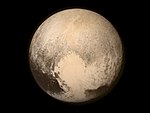astro.wikisort.org - Meteorite
K2-22b (also known as EPIC 201637175 b) is an exoplanet 801 ly from Earth, rapidly orbiting the red dwarf K2-22 with an orbital period of 9.145872 hours.[2] It has a mass below 445 Me and a radius below 2.5 Re. The planet was not detected in the K2 photometry. K2 photometry reveals the presence of an anomalous light curve consistent with evaporation of dust from the planet. This dust forms a tail both ahead and behind the planet, similar to some comets in the Solar System.[1] The evaporation of this dust requires a low surface gravity from the host planet, implying it is a low mass, "Mars, Mercury, or even lunar sized bodies with surface gravities of 1/6 to 1/3 that of Earth are to be preferred."[1]
| Discovery[1] | |
|---|---|
| Discovery site | Kepler Space Observatory |
| Discovery date | 2015 |
Detection method | Transit |
| Orbital characteristics | |
Semi-major axis | 0.0088 AU (1,320,000 km) |
| Eccentricity | null[2] |
Orbital period (sidereal) | 0.381078[2] d |
| Inclination | null[2] |
| Star | K2-22 |
| Physical characteristics | |
Mean radius | <0.71REarth[3] |
| Mass | 0.02 MEarth[3] |
| Temperature | 2,100 K (1,830 °C; 3,320 °F) |
The survey in 2020 has failed to validate the existence of the planet, although did not claim it to be a false positive.[4]
The observation of planetary system in 2021 has failed to detect the planet itself, placing an upper limit of 0.71REarth on its size. With the observed mass loss rate, the probable planet mass is 0.02MEarth, and the planet will be gone in 21 million years in future.[3]
See also
 Astronomy portal
Astronomy portal- List of exoplanet extremes
References
- Sanchis-Ojeda, R.; et al. (2015). "The K2-ESPRINT Project I: Discovery of the Disintegrating Rocky Planet K2-22b with a Cometary Head and Leading Tail". The Astrophysical Journal. 812 (2). 112. arXiv:1504.04379. Bibcode:2015ApJ...812..112S. doi:10.1088/0004-637X/812/2/112.
- "K2-22 b CONFIRMED PLANET OVERVIEW PAGE". NASA Exoplanet Archive. Retrieved 2015-10-14.
- LBT Reveals Large Dust Particles and a High Mass Loss Rate for K2-22 b, 2021, arXiv:2106.07648
- Adams, Elisabeth R.; Jackson, Brian; Johnson, Samantha; Ciardi, David R.; Cochran, William D.; Endl, Michael; Everett, Mark E.; Furlan, Elise; Howell, Steve B.; Jayanthi, Prasanna; MacQueen, Phillip J.; Matson, Rachel A.; Partyka-Worley, Ciera; Schlieder, Joshua; Scott, Nicholas J.; Stanton, Sevio M.; Ziegler, Carl (2020), ULTRA SHORT PERIOD PLANETS IN K2 III: NEIGHBORS ARE COMMON WITH 12 NEW MULTI-PLANET SYSTEMS AND 26 NEWLY VALIDATED PLANETS IN CAMPAIGNS 0-8, 10, arXiv:2011.11698
На других языках
- [en] K2-22b
[es] K2-22b
K2-22b (también conocido como EPIC 201637175 b [1]) es un exoplaneta 801 años luz de la Tierra, orbitando rápidamente a la enana roja K2-22 con un período orbital de 9.145872 horas. Tiene una masa inferior a 445 de la masa terrestre y un radio inferior a 2.5 del radio terrestre. La fotometría K2 revela la presencia de una curva de luz anómala consistente con la evaporación del polvo del planeta. Este polvo forma una cola tanto delante como detrás del planeta, similar a algunos cometas del Sistema Solar. La evaporación de este polvo requiere una baja gravedad de la superficie del planeta anfitrión, lo que implica que es una masa baja, "Marte, Mercurio, o incluso cuerpos de tamaño lunar con gravedad de 1/6 a 1/3 de la Tierra son preferibles". Este polvo puede estar relacionado con el acercamiento del planeta al límite de Roche impuesto por la estrella, comenzando esta última a quitarle su atmósfera para luego desintegrarlo (Ridden-Harper et al. 2019).Другой контент может иметь иную лицензию. Перед использованием материалов сайта WikiSort.org внимательно изучите правила лицензирования конкретных элементов наполнения сайта.
WikiSort.org - проект по пересортировке и дополнению контента Википедии


